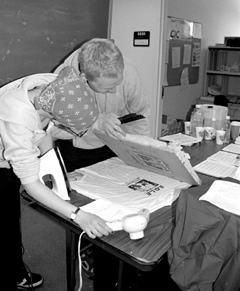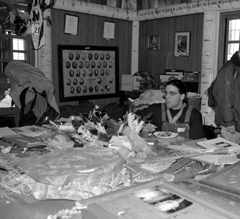Editor’s Note: Click here for a statement issued Feb. 13 by Royster Harper, interim vice president for student affairs, and click here for a statement issued Feb. 17 by President Lee C. Bollinger.
By Jane R. Elgass

The University’s membership in the Workers’ Rights Consortium, the controversy surrounding the Michigamua Senior Society’s occupation of space in the Michigan Union tower and demands included in a petition presented to the University by the Students of Color Coalition (SCC) were the focus of speakers’ remarks at the public comments session of the Regents’ Feb. 17 meeting.
Sweatshops
Speaking on behalf of Students Organizing for Labor and Economic Equality (SOLE), Peter Romer-Friedman cited the establishment Feb. 16 of a mock sweatshop in the office of LS&A Dean Shirley Neuman. He noted that the mock sweatshop provides a visible symbol to call people’s attention to the fact that real ones have not disappeared.
Romer-Friedman also noted that “more than enough time has passed” for the University to consider membership in the Workers’ Rights Consortium (WRC), referring to actions taken a year ago on a code for companies that manufacture U-M logo apparel and other items, and the ongoing work of an advisory committee headed by John Chamberlain.
The University in March 1999 released a code of conduct to which vendors who are licensed to produce apparel and other U-M items are held. In announcing adoption of the code at the time, President Lee C. Bollinger said, “We believe that workers should receive wages that at least meet their basic needs and respect their basic human rights. Human rights is a concept that we highly value as an institution.”
The code’s provisions include ensuring compensation standards, humane limitations on required work hours, limitations on child labor, and a safe and healthy work environment.
In June, Bollinger appointed an Advisory Committee on Labor Standards and Human Rights, as called for in the code. The president asked the committee to study and recommend actions in at least four key areas:
Letters were sent in late July advising vendors that, as part of compliance with the code, they would be required to disclose manufacturing locations by Jan. 1, 2000. Formal notification of the requirement was sent to manufacturers in December 1999 by the Collegiate Licensing Company, which represents 172 colleges and universities.
Earlier this month, Bollinger announced that he is deferring a decision on whether the University will endorse the WRC labor policy, indicating the need for further study of the policy and other means of monitoring licensee conduct toward workers.

The WRC was developed by the United Students Against Sweatshops (USAS) and consists of a system to verify and inspect conditions in factories producing collegiate logo items.
USAS members believe the WRC would make public information on industry practices and pressure manufacturers to improve working conditions.
Mariah Cherem, who also spoke on behalf of SOLE, noted that the group wants to continue talking with University officials and that it is encouraged by recent discussions with Bollinger and Marvin Krislov, vice president and general counsel.
Romer-Friedman added that the “dialogue is positive now,” expressing hope that the administration “will agree to support these workers.”
Students of Color Coalition
Several representatives of the Students of Color Coalition asked for renewed attention on the part of the University to a petition presented to the administration on Feb. 4 that detailed demands in 14 areas, including a call for the U-M to sever all ties with Michigamua.
Referring to a statement issued by Bollinger before the start of the public comments session (see page 4), Aqueelah Cowan criticized the University’s response to occupation of the Union tower space, noting that the “administration says it is accountable to students but it is now the 12th day of occupation and you are just now making a statement.”
“Are we not respected as students, as students of color?” she asked.
Michigamua and the occupation of the tower space “reflects a serious situation,” Sabrina Charles said. “The University of Michigan ascribes to values of diversity and multiculturalism, but does not provide an environment conducive to that. It has been slow to respond to demographic changes,” she said, “and students of color are unable to flourish.”
The exclusionary nature of Michigamua and its special status are particularly troubling, she noted.
Charles also noted several areas in which she said the University has fallen short, including under-funding and under-staffing the Multi-Ethnic Student Affairs office, failure to give the Center for Afroamerican and African Studies departmental status, and the lack of enough minority peer advisers to serve incoming students.
“We look at Michigamua as an example of access denied,” she said. “Students of color are at the bottom of the totem pole.”
Asserting that the University has not paid proper attention to the needs of minority students over the past five years, JuJuan Buford said, “we have been confronted by negligence. We didn’t have much choice about [the tower takeover] when the administration has not responded to five years of petitions. The issues have not been addressed.”
Monique Gifford also criticized the University for not reacting to “cultural atrocities,” adding that the “devastating lack of response” to the petition has created “almost total distrust of those who run the University. If there is continuing negligence, we have no choice but to seek outside support. I urge you to resolve this expeditiously.”
Michigamua
Joe Reilly, one of the students occupying the Union tower space, noted that the 12 days of occupation reflect three decades of attempted negotiations with Michigamua, which had appropriated Native American items and traditions in an offensive manner and “98 years of institutional racism at the University. I am a victim and a survivor,” he stated.
Reilly noted that Michigamua agreed in 1989 to eliminate all references to Native American culture. “The bottom line is that Michigamua has kept its traditions,” he said, referring to a log book kept by the organization. “We were forced to take action into our own hands.”
He asked whether the University would support the existence of a Nazi group or the Ku Klux Klan. “Why are my people not attributed the same rights? What condition has allowed this form of racism to continue?”
Speaking on behalf of Michigamua, Nicholas Delgado said the organization “apologizes for this breach of faith. More importantly, Michigamua also sincerely and deeply apologizes to members of the Native American and University communities to whom these actions have caused offense.
“The Class of 2000 is committed to working with the Native American community and the University administration to better understand the nature of our previous misjudgments and to ensure that these errors will never be repeated again.”

